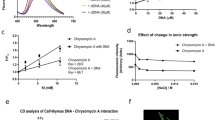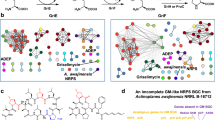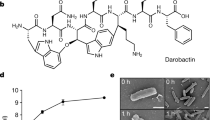Abstract
The antimicrobial resistance crisis requires the introduction of novel antibiotics. The use of conventional broad-spectrum compounds selects for resistance in off-target pathogens and harms the microbiome. This is especially true for Mycobacterium tuberculosis, where treatment requires a 6-month course of antibiotics. Here we show that a novel antimicrobial from Photorhabdus noenieputensis, which we named evybactin, is a potent and selective antibiotic acting against M. tuberculosis. Evybactin targets DNA gyrase and binds to a site overlapping with synthetic thiophene poisons. Given the conserved nature of DNA gyrase, the observed selectivity against M. tuberculosis is puzzling. We found that evybactin is smuggled into the cell by a promiscuous transporter of hydrophilic compounds, BacA. Evybactin is the first, but likely not the only, antimicrobial compound found to employ this unusual mechanism of selectivity.

This is a preview of subscription content, access via your institution
Access options
Access Nature and 54 other Nature Portfolio journals
Get Nature+, our best-value online-access subscription
$29.99 / 30 days
cancel any time
Subscribe to this journal
Receive 12 print issues and online access
$259.00 per year
only $21.58 per issue
Buy this article
- Purchase on Springer Link
- Instant access to full article PDF
Prices may be subject to local taxes which are calculated during checkout





Similar content being viewed by others
Data availability
M. tuberculosis genome data (NC_000962.3) were used as a reference of genome sequencing. All data supporting the findings of this study are available within the paper and its Supplementary Information or have been deposited to the indicated databases. The genome of P. noenieputensis DSM 25462 has been deposited to GenBank with accession number RCWC00000000.1. Structural data have been deposited in the PDB with PDB identifier 7UGW. All other data are available from the corresponding author upon reasonable request. Source data are provided with this paper.
References
Keshavjee, S. & Farmer, P. E. Tuberculosis, drug resistance, and the history of modern medicine. N. Engl. J. Med. 367, 931–936 (2012).
Schatz, A., Bugie, E. & Waksman, S. A. Streptomycin, a substance exhibiting antibiotic activity against gram-positive and gram-negative bacteria. 1944. Clin. Orthop. Relat. Res. 3–6 (2005).
Hinshaw, H. C., Pyle, M. M. & Feldman, W. H. Streptomycin in tuberculosis. Am. J. Med 2, 429–435 (1947).
Chakaya, J. et al. Global Tuberculosis Report 2020—reflections on the global TB burden, treatment and prevention efforts. Int. J. Infect. Dis. S7–S12 (2021).
Zumla, A., Nahid, P. & Cole, S. T. Advances in the development of new tuberculosis drugs and treatment regimens. Nat. Rev. Drug Discov. 12, 388–404 (2013).
Sacchettini, J. C., Rubin, E. J. & Freundlich, J. S. Drugs versus bugs: in pursuit of the persistent predator Mycobacterium tuberculosis. Nat. Rev. Microbiol. 6, 41–52 (2008).
Shreiner, A. B., Kao, J. Y. & Young, V. B. The gut microbiome in health and in disease. Curr. Opin. Gastroenterol. 31, 69–75 (2015).
Gavrish, E. et al. Lassomycin, a ribosomally synthesized cyclic peptide, kills Mycobacterium tuberculosis by targeting the ATP-dependent protease ClpC1P1P2. Chem. Biol. 21, 509–518 (2014).
Quigley, J. et al. Novel antimicrobials from uncultured bacteria acting against Mycobacterium tuberculosis. mBio 11, e01516-20 (2020).
Pantel, L. et al. Odilorhabdins, antibacterial agents that cause miscoding by binding at a new ribosomal site. Mol. Cell 70, 83–94 (2018).
Racine, E. et al. In vitro and in vivo characterization of NOSO-502, a novel inhibitor of bacterial translation. Antimicrob. Agents Chemother. 62, e01016-18 (2018).
Imai, Y. et al. A new antibiotic selectively kills Gram-negative pathogens. Nature 576, 459–464 (2019).
Kaur, H. et al. The antibiotic darobactin mimics a β-strand to inhibit outer membrane insertase. Nature 593, 125–129 (2021).
Chan, P. F. et al. Thiophene antibacterials that allosterically stabilize DNA-cleavage complexes with DNA gyrase. Proc. Natl Acad. Sci. USA 114, E4492–E4500 (2017).
Blin, K. et al. antiSMASH 5.0: updates to the secondary metabolite genome mining pipeline. Nucleic Acids Res. 47, W81–W87 (2019).
Braun, V., Pramanik, A., Gwinner, T., Koberle, M. & Bohn, E. Sideromycins: tools and antibiotics. Biometals 22, 3–13 (2009).
Luna, B. et al. A nutrient-limited screen unmasks rifabutin hyperactivity for extensively drug-resistant Acinetobacter baumannii. Nat. Microbiol 5, 1134–1143 (2020).
Gopinath, K. et al. A vitamin B-12 transporter in Mycobacterium tuberculosis. Open Biol. 3, 120175 (2013).
Rempel, S. et al. A mycobacterial ABC transporter mediates the uptake of hydrophilic compounds. Nature 580, 409–412 (2020).
Domenech, P., Kobayashi, H., LeVier, K., Walker, G. C. & Barry, C. E. III BacA, an ABC transporter involved in maintenance of chronic murine infections with Mycobacterium tuberculosis. J. Bacteriol. 191, 477–485 (2009).
Lavina, M., Pugsley, A. P. & Moreno, F. Identification, mapping, cloning and characterization of a gene (sbmA) required for microcin B17 action on Escherichia coli K12. J. Gen. Microbiol. 132, 1685–1693 (1986).
Salomon, R. A. & Farias, R. N. The peptide antibiotic microcin 25 is imported through the Tonb pathway and the Sbma protein. J. Bacteriol. 177, 3323–3325 (1995).
Ling, L. L. et al. Identification and characterization of inhibitors of bacterial enoyl-acyl carrier protein reductase. Antimicrob. Agents Chemother. 48, 1541–1547 (2004).
Nonejuie, P., Burkart, M., Pogliano, K. & Pogliano, J. Bacterial cytological profiling rapidly identifies the cellular pathways targeted by antibacterial molecules. Proc. Natl Acad. Sci. USA 110, 16169–16174 (2013).
Kumar, K. et al. Discovery of anti-TB agents that target the cell-division protein FtsZ. Future Med. Chem. 2, 1305–1323 (2010).
Chung, C. C. et al. Screening of antibiotic susceptibility to β-lactam-induced elongation of Gram-negative bacteria based on dielectrophoresis. Anal. Chem. 84, 3347–3354 (2012).
Matrat, S. et al. Functional analysis of DNA gyrase mutant enzymes carrying mutations at position 88 in the A subunit found in clinical strains of Mycobacterium tuberculosis resistant to fluoroquinolones. Antimicrob. Agents Chemother. 50, 4170–4173 (2006).
Sugino, A., Peebles, C. L., Kreuzer, K. N. & Cozzarelli, N. R. Mechanism of action of nalidixic acid: purification of Escherichia coli nalA gene product and its relationship to DNA gyrase and a novel nicking-closing enzyme. Proc. Natl Acad. Sci. USA 74, 4767–4771 (1977).
Gellert, M., Mizuuchi, K., Odea, M. H., Itoh, T. & Tomizawa, J. I. Nalidixic acid resistance: a second genetic character involved in DNA gyrase activity. Proc. Natl Acad. Sci. USA 74, 4772–4776 (1977).
Snyder, M. & Drlica, K. DNA gyrase on the bacterial chromosome: DNA cleavage induced by oxolinic acid. J. Mol. Biol. 131, 287–302 (1979).
Dalhoff, A., Petersen, U. & Endermann, R. In vitro activity of BAY 12-8039, a new 8-methoxyquinolone. Chemotherapy 42, 410–425 (1996).
Aubry, A., Fisher, L. M., Jarlier, V. & Cambau, E. First functional characterization of a singly expressed bacterial type II topoisomerase: the enzyme from Mycobacterium tuberculosis. Biochem. Biophys. Res. Commun. 348, 158–165 (2006).
Blower, T. R., Williamson, B. H., Kerns, R. J. & Berger, J. M. Crystal structure and stability of gyrase–fluoroquinolone cleaved complexes from Mycobacterium tuberculosis. Proc. Natl Acad. Sci. USA 113, 1706–1713 (2016).
Villar, E. A. et al. How proteins bind macrocycles. Nat. Chem. Biol. 10, 723–731 (2014).
Laponogov, I. et al. Structural insight into the quinolone-DNA cleavage complex of type IIA topoisomerases. Nat. Struct. Mol. Biol. 16, 667–669 (2009).
Wohlkonig, A. et al. Structural basis of quinolone inhibition of type IIA topoisomerases and target-mediated resistance. Nat. Struct. Mol. Biol. 17, 1152–−1153 (2010).
Mattiuzzo, M. et al. Role of the Escherichia coli SbmA in the antimicrobial activity of proline-rich peptides. Mol. Microbiol. 66, 151–−163 (2007).
Petrella, S. et al. Overall structures of Mycobacterium tuberculosis DNA gyrase reveal the role of a corynebacteriales GyrB-specific insert in ATPase activity. Structure 27, 579 (2019).
Schindelin, J. et al. Fiji: an open-source platform for biological-image analysis. Nat. Methods 9, 676–682 (2012).
Ducret, A., Quardokus, E. M. & Brun, Y. V. MicrobeJ, a tool for high throughput bacterial cell detection and quantitative analysis. Nat. Microbiol. 1, https://doi.org/10.1038/Nmicrobiol.2016.77 (2016)
Wick, R. R., Judd, L. M., Gorrie, C. L. & Holt, K. E. Unicycler: resolving bacterial genome assemblies from short and long sequencing reads. PLoS Comput. Biol. 3, e1005595 (2017).
Deatherage, D. E. & Barrick, J. E. Identification of mutations in laboratory-evolved microbes from next-generation sequencing data using breseq. Methods Mol. Biol. 1151, 165–188 (2014).
van Kessel, J. C. & Hatfull, G. F. Recombineering in Mycobacterium tuberculosis. Nat. Methods 4, 147–152 (2007).
Barkan, D., Rao, V., Sukenick, G. D. & Glickman, M. S. Redundant function of cmaA2 and mmaA2 in Mycobacterium tuberculosis cis cyclopropanation of oxygenated mycolates. J. Bacteriol. 192, 3661–3668 (2010).
van Kessel, J. C. & Hatfull, G. F. Efficient point mutagenesis in mycobacteria using single-stranded DNA recombineering: characterization of antimycobacterial drug targets. Mol. Microbiol. 67, 1094–1107 (2008).
Norby, J. G. Coupled assay of Na+, K+-ATPase activity. Methods Enzymol. 156, 116–119 (1988).
Studier, F. W. Protein production by auto-induction in high-density shaking cultures. Protein Expr. Purif. 41, 207–234 (2005).
Bax, B. D. et al. Type IIA topoisomerase inhibition by a new class of antibacterial agents. Nature 466, 935–951 (2010).
Winter, G. & McAuley, K. E. Automated data collection for macromolecular crystallography. Methods 55, 81–93 (2011).
Mccoy, A. J. et al. Phaser crystallographic software. J. Appl. Crystallogr. 40, 658–674 (2007).
Emsley, P. & Cowtan, K. Coot: model-building tools for molecular graphics. Acta Crystallogr. D 60, 2126–2132 (2004).
Jones, D. T., Taylor, W. R. & Thornton, J. M. The rapid generation of mutation data matrices from protein sequences. Comput. Appl. Biosci. 8, 275–282 (1992).
Kumar, S., Stecher, G. & Tamura, K. MEGA7: molecular evolutionary genetics analysis version 7.0 for bigger datasets. Mol. Biol. Evol. 33, 1870–1874 (2016).
Slotboom, D. J., Ettema, T. W., Nijland, M. & Thangaratnarajah, C. Bacterial multi-solute transporters. FEBS Lett. 594, 3898–3907 (2020).
Schmidt, B. H., Osheroff, N. & Berger, J. M. Structure of a topoisomerase II-DNA-nucleotide complex reveals a new control mechanism for ATPase activity. Nat. Struct. Mol. Biol. 19, 1147–1154 (2012).
Acknowledgements
This work was supported by National Institutes of Health grants P01AI118687 (K.L.), R01CA077373 (J.B.) and R35263778 (J.B.). Part of this work was conducted at the AMX beamline of the National Synchrotron Light Source II, a U.S. Department of Energy (DOE) Office of Science User Facility operated for the DOE Office of Science by Brookhaven National Laboratory under contract number DE-SC0012704. The AMX beamline is a member of the the Center for BioMolecular Structure, which is primarily supported by the National Institute of General Medical Sciences through a Center Core P30 grant (P30GM133893) and by the DOE Office of Biological and Environmental Research (KP1607011). We thank D. J. Slotboom (University of Groningen) for providing BacA/BacA-like transporter protein sequences. We thank S. Abbatiello and A. Iinishi (Northeastern University) and Y.-S. Hong (Korea Research Institute of Bioscience and Biotechnology) for help with LC–MS experiments. We acknowledge the Korea Basic Science Institute for providing NMR data. We appreciate discussions with G.E. Martin (Seton Hall University) and J. Oh (Yale University) about the 1,1- ADEQUATE NMR experiment.
Author information
Authors and Affiliations
Contributions
K.L. designed the study, analyzed results and wrote the paper. J.B. designed the study, analyzed results and wrote the paper. Y.I. identified evybactin, designed the study, analyzed results and wrote the paper. G.H. designed the DNA gyrase A study, analyzed results and wrote the paper. J.Q. generated evybactin-resistant mutants and performed susceptibility studies with M.G. and M.M. L.L. identified evybactin BGCs and identified the structure of evybactin with S.S., D.B., C.H., X.M. and J.J.G. M.F.G. performed microscopy studies and analyzed data. N.S. purified evybactin. S.N. performed animal studies.
Corresponding authors
Ethics declarations
Competing interests
The authors declare no competing interests.
Peer review
Peer review information
Nature Chemical Biology thanks Anthony Maxwell and the other, anonymous, reviewer(s) for their contribution to the peer review of this work.
Additional information
Publisher’s note Springer Nature remains neutral with regard to jurisdictional claims in published maps and institutional affiliations.
Extended data
Extended Data Fig. 1 NMR structural determination of evybactin in DMSO-d6.
a, 1H. b, 13C. c, COSY. d, ROESY. e, 1H-13C HSQC. f, 1H-13C HMBC.
Extended Data Fig. 2 2D NMR key correlations for evybactin structural assignment.
All correlations were measured in DMSO-d6 except for the HMBC correlation from H-41 to C-2 was recorded in D2O.
Extended Data Fig. 3 Efficacy of evybactin in an animal model.
Mice were infected by E. coli ATCC 25922 through intraperitoneal injection, and antibiotics were administrated 1 h later. Survival was monitored over 5 days. The experiment was repeated three times (n=4 biologically independent mice); lines are the mean of experiments. Gentamicin (Gen) was used as a positive control. All treatment are in mg kg−1.
Extended Data Fig. 4 BacA homologs are distributed among bacteria.
BacA phylogenic tree was generated by using the Maximum Likelihood method based on the JTT matrix-based model52. The tree with the highest log likelihood (−8349.22) is shown. Initial tree(s) for the heuristic search were obtained automatically by applying Neighbor-Join and BioNJ algorithms to a matrix of pairwise distances estimated using a JTT model, and then selecting the topology with superior log likelihood value. The tree is drawn to scale, with branch lengths measured in the number of substitutions per site. The analysis involved 17 amino acid sequences. All positions containing gaps and missing data were eliminated. There were a total of 274 positions in the final dataset. Evolutionary analyses were conducted in MEGA753. Protein sequences were obtained from a previous study54.
Extended Data Fig. 5 Evybactin inhibits DNA synthesis.
Effect of evybactin on macromolecular biosyntheses in E. coli WO153. Incorporation of 14C-thymidine (DNA), 14C- uridine (RNA), 14C -L-amino acid mixture (protein), 14C-Acetic acid (fatty acid) and 14C-acetyl-glucosamine (peptidoglycan) was determined in cells treated with 8x MIC of evybactin (grey bars). Ciprofloxacin (8x MIC), rifampicin (8x MIC), chloramphenicol (8x MIC), triclosan (8xMIC) and fosfomycin (8x MIC) were used as controls (white bars). Values are plotted as mean values ±SD, n=3 independent biochemical experiments.
Extended Data Fig. 6 Comparison of evybactin and thiophene binding.
a, Electron density omit maps for evybactin contoured at 1σ. Gyrase is depicted as a blue cartoon and evybactin as magenta sticks. b, Comparison of the evybactin-binding pocket (top panels) with the thiophene-binding pocket (bottom panels – PDB ID: 5NPK14). Gyrase subunits are colored in dark blue (GyrA) and light blue (GyrB) with evybactin and the thiophene colored magenta and green, respectively. Hydrophobic residues forming the shared evybactin and thiophene binding pocket are labeled (left panels). A glutamate residue in GyrB that is critical for thiophene binding to S. aureus gyrase (E634) is a threonine (T664) in M. tuberculosis gyrase (right panels). c, Electron density omit maps (1σ) for the evybactin-bound M. tuberculosis gyrase structure (left) and the thiophene-bound S. aureus gyrase structure (right, PDBID: 5NPK). Gyrase is colored in green and DNA is orange.
Extended Data Fig. 7 Mutations at the evybactin binding site effect evybactin and moxifloxacin induced cleavage.
a, Plots represent quantitation of evybactin- and moxifloxacin-induced cleavage in the presence of ATP. Fraction of linearized plasmid plotted at indicated concentrations of compound (0-500 µM). Cleavage was conducted with 20 nM wild-type MtbGyrase or MtbGyrase GyrA mutants and 6 nM DNA. Lines represent non-linear fits to the data, as in Fig. 4, values are plotted as mean values ±SD, n=3 independent biochemical experiments. b, Representative cleavage assays used for quantitation. Samples were separated on agarose gels run in the presence of ethidium bromide. The positions of nicked, linear, and uncleaved plasmid are indicated.
Extended Data Fig. 8 Evybactin and moxifloxacin stimulated cleavage activity of M. tuberculosis gyrase mutants.
Native agarose gel-based cleavage assay conducted with 125 nM gyrase, 6 nM plasmid DNA, and indicated amounts of evybactin or moxifloxacin (0-20 µM). Mutations in GyrA or GyrB are indicated above each panel. The positions of nicked, linear, and supercoiled plasmid DNA are indicated. Note that high protein concentrations are used to see activity in the resistance mutants; as a result, the DNA in the WT MtbGyrase reactions becomes degraded and disappears as evybactin concentrations are increased due to the presence of multiple, randomly spaced cleavage complexes. All assays repeated at least 2 times with similar results.
Extended Data Fig. 9 Supercoiling activities of M. tuberculosis gyrase mutants.
Native agarose gel analysis of supercoiling activity using indicated amounts of M. tuberculosis gyrase and resistance mutants (0-20 nM). The migration positions of relaxed starting material and supercoiled products are indicated. All assays repeated at least 3 times with similar results.
Extended Data Fig. 10 The evybactin binding pocket is concealed in the M. tuberculosis gyrase ‘ATPase open’ state.
Structure of S. cerevisiae TOP2 bound to DNA and nonhydrolyzable ATP analog, illustrating the ‘ATPase closed’ conformation of type-II topoisomerases (left, PDBID: 4GFH55). The ATPase and transducer domains are colored yellow and light green, the nucleolytic core is illustrated in orange and blue, and DNA is shown in grey. Structure of M. tuberculosis gyrase in an ‘ATPase open’ state (right, PDBID: 6GAV38), in which the ATPase regions are folded down from the position shown at left. The binding site for evybactin is illustrated as a black outline and shown as a purple surface in the inset. The inset shows the loop within the GyrB ATPase domain that is specific to Corynebacteriales gyrases and how this loop occludes the evybactin binding site in the ‘ATPase open’ conformation of the enzyme.
Supplementary information
Supplementary Information
Supplementary Figs. 1–5 and Supplementary Tables 1–8
Source data
Source Data Fig. 4
Uncropped gels
Source Data Extended Data Fig. 7
Uncropped gels
Source Data Extended Data Fig. 8
Uncropped gels
Source Data Extended Data Fig. 9
Uncropped gels
Rights and permissions
Springer Nature or its licensor holds exclusive rights to this article under a publishing agreement with the author(s) or other rightsholder(s); author self-archiving of the accepted manuscript version of this article is solely governed by the terms of such publishing agreement and applicable law.
About this article
Cite this article
Imai, Y., Hauk, G., Quigley, J. et al. Evybactin is a DNA gyrase inhibitor that selectively kills Mycobacterium tuberculosis. Nat Chem Biol 18, 1236–1244 (2022). https://doi.org/10.1038/s41589-022-01102-7
Received:
Accepted:
Published:
Issue Date:
DOI: https://doi.org/10.1038/s41589-022-01102-7
This article is cited by
-
Bidirectional ATP-driven transport of cobalamin by the mycobacterial ABC transporter BacA
Nature Communications (2024)
-
DNA gyrase inhibitor targets M. tuberculosis
Nature Reviews Drug Discovery (2022)



